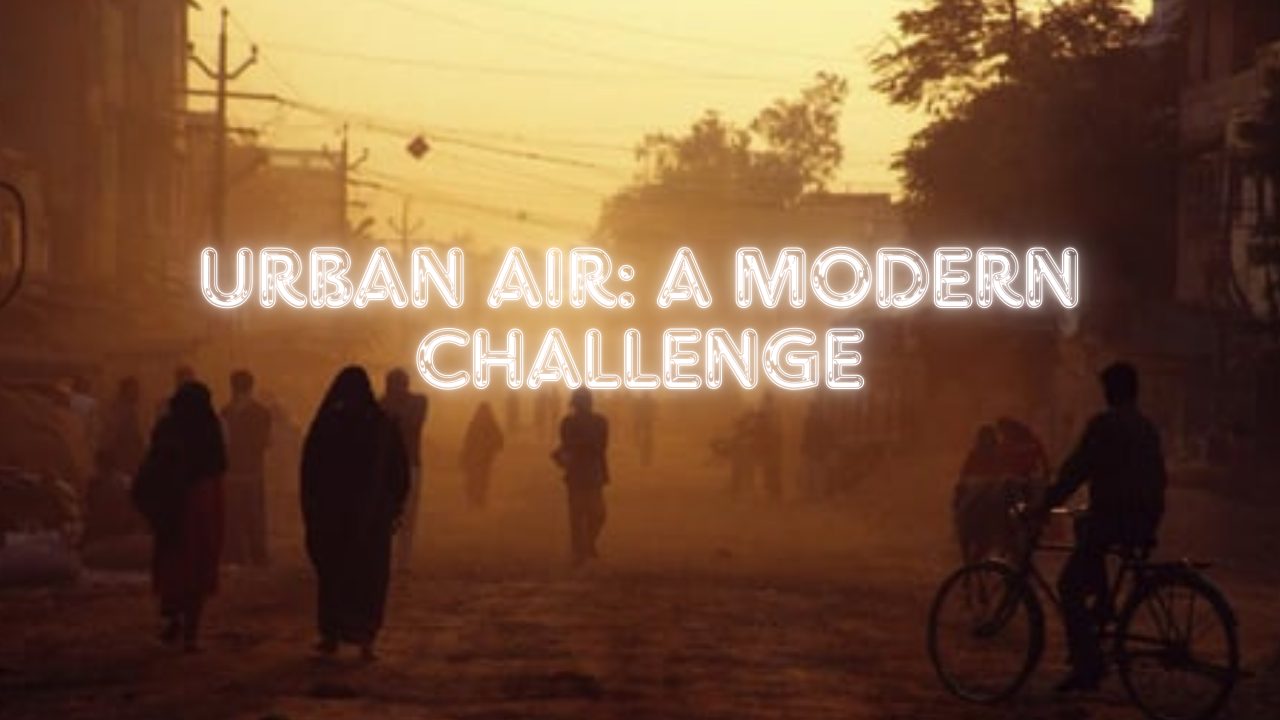Table of Contents
Urban air quality has become a pressing issue as cities around the world continue to grow and develop. The rapid expansion of urban areas, coupled with the increased use of fossil fuels and industrial activities, has led to a significant decline in air quality. This issue is further compounded by the high population density in cities, which increases the concentration of pollutants in the air. As a result, the air we breathe in cities is often filled with harmful substances that can have serious consequences for both human health and the environment.
In many cities, the air quality has reached dangerous levels, prompting governments and organizations to take action. The situation is especially dire in developing countries, where rapid industrialization and urbanization often outpace the implementation of environmental regulations. In these regions, the lack of infrastructure and resources to combat pollution exacerbates the problem, leaving millions of people exposed to unhealthy air.
Addressing urban air pollution is not just about improving the quality of life for city dwellers; it is also about safeguarding the environment. Polluted air contributes to climate change by increasing the concentration of greenhouse gases in the atmosphere. Additionally, it affects ecosystems by contaminating soil and water, disrupting the natural balance. Therefore, tackling urban air pollution is a crucial step in ensuring a sustainable future for our planet.
The Sources of Urban Air Pollution
Urban air pollution primarily stems from two major sources: transportation and industry. The widespread use of vehicles, especially those powered by fossil fuels, is a significant contributor to air pollution. Cars, trucks, buses, and motorcycles release large quantities of pollutants, such as nitrogen oxides (NOx) and particulate matter (PM), into the atmosphere. These pollutants are harmful not only to human health but also to the environment, as they contribute to the formation of smog and acid rain.
Industrial activities also play a major role in urban air pollution. Factories, power plants, and other industrial facilities emit various pollutants, including sulfur dioxide (SO2) and volatile organic compounds (VOCs). These substances can react with other elements in the air to form secondary pollutants, such as ground-level ozone, which is a key component of smog. The concentration of industries in urban areas further exacerbates the problem, as it leads to higher levels of pollution in cities.
Additionally, urban air pollution can be exacerbated by natural factors, such as weather patterns and geographic location. For instance, cities located in valleys or surrounded by mountains may experience higher levels of pollution due to the trapping of air pollutants in the lower atmosphere. Similarly, during periods of high pressure, pollutants can accumulate in the air, leading to smog formation. Understanding the various sources of urban air pollution is essential for developing effective strategies to combat it.
Health Impacts of Poor Urban Air Quality
The health impacts of poor urban air quality are profound and wide-ranging. Long-term exposure to polluted air is linked to a variety of respiratory diseases, including asthma, bronchitis, and chronic obstructive pulmonary disease (COPD). These conditions can significantly reduce the quality of life and, in severe cases, can be fatal. Children and the elderly are particularly vulnerable, as their respiratory systems are either still developing or have weakened with age, making them more susceptible to the harmful effects of air pollution.
Moreover, air pollution is not limited to respiratory illnesses. Recent studies have shown that prolonged exposure to polluted air can lead to cardiovascular diseases, such as heart attacks and strokes. Pollutants like particulate matter can penetrate deep into the lungs and enter the bloodstream, where they can cause inflammation and damage to blood vessels. This increases the risk of heart disease and other cardiovascular problems, contributing to higher mortality rates in urban areas with poor air quality.
In addition to physical health, there is growing evidence that air pollution can affect mental health as well. Exposure to high levels of pollutants has been linked to cognitive decline and mental health disorders, such as depression and anxiety. The impact of air pollution on mental health is a relatively new area of research, but the findings so far suggest that the consequences of poor air quality are even more far-reaching than previously thought. Addressing urban air pollution is, therefore, crucial not only for physical health but also for the overall well-being of urban populations.
Environmental Consequences
Urban air pollution has significant environmental consequences that extend beyond human health. One of the most visible effects is the formation of smog, a dense, hazy layer of air pollution that reduces visibility and gives cities a gray, grimy appearance. Smog is not just an aesthetic issue; it can also harm wildlife by disrupting natural habitats and interfering with the photosynthesis process in plants. This can lead to reduced biodiversity and the loss of species that are unable to adapt to the polluted environment.
Another major environmental consequence of urban air pollution is acid rain. Pollutants like sulfur dioxide (SO2) and nitrogen oxides (NOx) can react with water vapor in the atmosphere to form acidic compounds, which then fall to the ground as acid rain. Acid rain can have devastating effects on ecosystems, as it lowers the pH of soil and water bodies, making them inhospitable for many forms of life. It can also corrode buildings and infrastructure, leading to costly repairs and maintenance.
Urban heat islands are another consequence of poor air quality in cities. Due to the high concentration of buildings, vehicles, and industrial activities, urban areas tend to be warmer than their rural surroundings. This phenomenon, known as the urban heat island effect, can lead to higher energy consumption as residents rely more on air conditioning to cool their homes and workplaces. The increased energy demand, in turn, leads to more pollution as power plants burn more fossil fuels to meet the demand, creating a vicious cycle that exacerbates the problem of urban air pollution.
Innovative Solutions and Technologies
To address the challenges of urban air pollution, cities around the world are turning to innovative solutions and technologies. One of the most promising developments is the rise of electric vehicles (EVs), which produce zero tailpipe emissions. EVs are gradually replacing traditional gasoline-powered vehicles, helping to reduce the overall level of pollution in cities. Governments and companies are investing in the development of EV infrastructure, such as charging stations, to make these vehicles more accessible and encourage their widespread adoption.
Green building practices are also gaining traction as a way to combat urban air pollution. These practices involve designing and constructing buildings that are energy-efficient, use sustainable materials, and incorporate vegetation into their design. Green roofs, for example, can help absorb carbon dioxide and other pollutants, while also providing insulation to reduce energy consumption. Urban planners are increasingly recognizing the importance of integrating green spaces into cities, not only to improve air quality but also to enhance the overall quality of life for residents.
Advanced monitoring technologies are another key component of efforts to improve urban air quality. Air quality sensors can provide real-time data on pollution levels, allowing city authorities to identify problem areas and take immediate action. Predictive modeling tools can help forecast pollution events, enabling cities to implement preventive measures, such as traffic restrictions or temporary shutdowns of industrial activities. These technologies are crucial for effective air quality management, as they allow for more targeted and timely interventions.
The Role of Policy and Regulation
Effective policy and regulation are essential in the fight against urban air pollution. Governments play a crucial role in setting and enforcing emission standards for vehicles and industries. Stricter regulations on fuel quality, vehicle emissions, and industrial processes can significantly reduce the amount of pollutants released into the air. In addition, governments can promote the use of renewable energy sources, such as wind and solar power, to reduce reliance on fossil fuels, which are a major source of air pollution.
Investment in public transportation is another important policy measure to reduce urban air pollution. By providing reliable, affordable, and efficient public transportation options, cities can reduce the number of private vehicles on the road, thereby lowering overall emissions. Policies that encourage the use of bicycles and pedestrian-friendly infrastructure can also help to reduce air pollution, as they promote alternative modes of transportation that produce no emissions.
International cooperation is also vital in addressing urban air pollution, as pollutants do not respect national borders. Air pollution can travel long distances, affecting neighboring regions and even countries. Therefore, global agreements and collaborations, such as the Paris Agreement on climate change, are necessary to tackle this issue on a larger scale. Through shared knowledge, resources, and commitments, countries can work together to reduce air pollution and protect the health of people and the environment worldwide.
Community Involvement and Awareness
Community involvement is a critical aspect of efforts to improve urban air quality. Public awareness campaigns can play a significant role in educating citizens about the sources and dangers of air pollution. By raising awareness, these campaigns can encourage individuals to adopt more sustainable behaviors, such as reducing car use, conserving energy, and supporting clean energy initiatives. Educated citizens are more likely to demand action from policymakers and hold industries accountable for their environmental impact.
Local initiatives can also empower communities to take direct action to improve air quality. Urban greening projects, such as planting trees and creating green spaces, can help to absorb pollutants and improve the overall environment in cities. Car-free zones and pedestrian-friendly areas can reduce traffic congestion and lower emissions, while also creating more pleasant and livable urban spaces. These initiatives not only contribute to cleaner air but also foster a sense of community and shared responsibility among residents.
Furthermore, community involvement is essential for the success of policy measures aimed at reducing air pollution. Public support is crucial for the implementation of regulations, such as congestion charges or restrictions on vehicle use. When communities are actively engaged in the process, they are more likely to comply with and support these measures. By working together, communities can make a significant impact on urban air quality and create healthier, more sustainable cities for future generations.
Conclusion: A Shared Responsibility
Addressing the issue of urban air pollution requires a collective effort from governments, industries, and citizens. While the challenges are significant, the combined efforts of policy innovation, technological advancement, and community engagement offer a path towards cleaner, healthier cities. Governments must lead the way by implementing and enforcing regulations,

